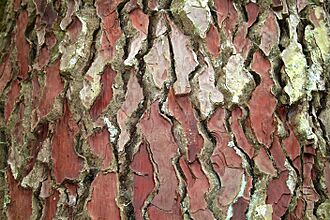Maritime pine facts for kids
Quick facts for kids Maritime pine |
|
|---|---|
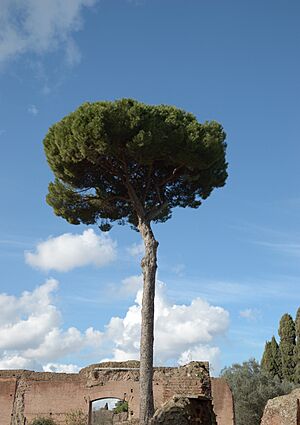 |
|
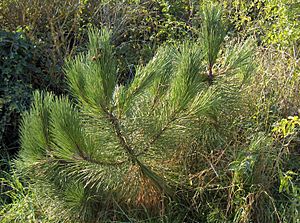 |
|
| Conservation status | |
| Scientific classification | |
| Genus: |
Pinus
|
| Species: |
pinaster
|
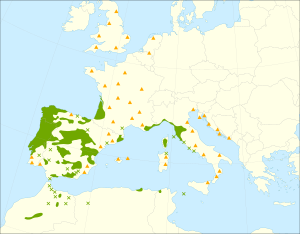 |
|
| Distribution map | |
| Synonyms | |
|
Maritime pine, cluster pine |
|
The maritime pine (also known as Pinus pinaster or cluster pine) is a type of pine tree. It grows naturally in the southern Atlantic Europe region and parts of the western Mediterranean. This tree grows quickly and has small seeds with large wings, which help them spread.
Contents
What the Maritime Pine Looks Like
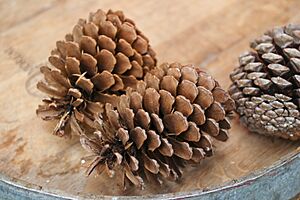
The maritime pine is a medium-sized tree. It can grow to be about 20 to 35 meters (65 to 115 feet) tall. Its trunk can be up to 1.2 meters (4 feet) wide.
The tree's bark is orange-red and very thick, especially near the bottom of the trunk. It has deep cracks, but it's a bit thinner higher up in the tree's crown (the leafy top part).
The leaves of the maritime pine are called 'needles'. They grow in pairs and are very thick, about 2 millimeters (1/16 inch) wide. They can be up to 25 centimeters (10 inches) long. These needles are bluish-green to yellowish-green. Maritime pines have the longest and strongest needles of all pine trees in Europe.
The cones are shaped like a cone. They are 10 to 20 centimeters (4 to 8 inches) long and 4 to 6 centimeters (1.5 to 2.5 inches) wide at the bottom when they are closed. When they first grow, they are green. After about two years, they turn shiny red-brown.
These cones open slowly over several years. They can also open quickly if there's a forest fire. Once open, they can be 8 to 12 centimeters (3 to 5 inches) wide. This helps release the seeds. The seeds are small, about 8 to 10 millimeters (1/3 inch) long, and have a large wing, about 20 to 25 millimeters (1 inch) long. The wind helps to spread these seeds far away.
Similar Pine Trees
The maritime pine is very similar to the Turkish pine, Canary Island pine, and Aleppo pine. They share many features. The maritime pine itself doesn't change much in how it looks across its whole natural range.
Where Maritime Pines Grow
The maritime pine grows in the western Mediterranean Basin and along the southern Atlantic coast of Europe. You can find it from central Portugal and northern Spain (especially in Galicia) to southern and Western France. It also grows east to western Italy, Croatia, and south to northern Tunisia, Algeria, and northern Morocco.
This tree loves a Mediterranean climate. This means it prefers cool, rainy winters and hot, dry summers. It usually grows at low to medium heights, mostly from sea level up to 600 meters (2,000 feet). However, in the southern parts of its range, like Morocco, it can grow up to 2,000 meters (6,500 feet) high. Its natural areas are often separated because of mountains and human activities.
How Maritime Pines Affect Nature
Scientists often study the maritime pine because it has spread a lot in South Africa over the past 150 years. It was brought to South Africa in the late 1600s. By the late 1700s, it was spreading in the Cape Peninsula. In the early 1800s, people started planting it widely for forestry (getting timber).
This pine tree can take over large areas, especially a type of plant community called fynbos. Fynbos is a shrubland in South Africa that often has fires. Maritime pines are found more often near watercourses (rivers or streams). How fast it spreads depends on how its seeds are spread, if it loses its natural habitat, and how many seeds it produces. It prefers acidic soils with lots of plants, but it can also grow in sandy or poor soils where other trees might not survive.
When Maritime Pines Invade
When the maritime pine spreads into new areas, it can become an invasive species. This means it grows so well that it can harm the native plants and animals.
Effects of Invasion
One big problem with maritime pine invading South Africa is that it reduces the variety of native living things, which is called biodiversity. When these trees take over, native species can become endangered or even disappear. For example, in the Cape Peninsula of South Africa, invasive species can reduce the diversity of native plants by 50–86%.
Maritime pines grow in shrublands. When shrublands are invaded by these trees, they lose the most plant species compared to other environments. Trees like the maritime pine have a bigger negative effect on the number of different species than grasses do. South Africa has seen a large decrease in species variety because of invasive species. Also, South Africa doesn't have many of the insects and diseases that naturally control the maritime pine's population in its home country.
Another major effect of maritime pine invasion is on water. If maritime pines grow in areas with grasses and shrubs, the water levels in streams can drop a lot. This is because maritime pines are evergreen trees, meaning they keep their leaves all year. They use much more water than grasses and shrubs. This reduces the amount of water available for other species.
Maritime pines often grow quickly in riparian zones, which are areas near water where plants grow very fast. They use up the water, leaving less for other plants and animals. For example, in the fynbos areas of the Western Cape in South Africa, streamflow decreased by 55% after pines were planted for 23 years. In another area, 6 streams completely dried up 12 years after pines replaced grasslands. When some of these pines were removed, the streamflow increased significantly.
The growth of maritime pines can also mean less grass for livestock (farm animals) to eat. When some pines were removed from a plantation, the grazing conditions for sheep improved a lot. So, the invasion of maritime pines can lead to less plant life for animals and less water.
How Maritime Pines Interact with Nature
Maritime pines are very successful in fynbos areas because they are good at surviving intense fires. Their cones release seeds when it's hot, which helps them grow back quickly after a fire. This gives them an advantage over other plants that aren't as good at recovering from fires.
Studies in Spain show that maritime pines can grow back very well on their own. They can have many seedlings (young trees) per square meter in the first year. However, these seedlings then compete with each other for space and resources.
Other reasons for their success include their fast growth and their small seeds with large wings. Growing quickly helps them outcompete native species. Their small, winged seeds are perfect for spreading by wind, especially in windy, mountainous areas like the fynbos. This efficient way of spreading seeds is key to why they have invaded places like South Africa.
Maritime pines also produce special oily substances called oleoresins. These are like a defense mechanism against insects. These resins can stop other plants from growing nearby. When insects like the large pine weevil attack the pine, it produces more of these resins. This helps the tree protect itself without wasting energy when there's no danger. This ability to defend themselves helps maritime pines survive and thrive in new places.
Ways to Control Maritime Pines
One way to control the spread of maritime pines is using biological control. This means using natural enemies, like insects or mites, that feed on the pine's seeds or cones. An ideal biological control agent should:
- Reproduce quickly.
- Only feed on maritime pines (be "host-specific").
- Have a life cycle that matches the pine's.
- Be able to survive even if the pine population starts to decline.
Insects that eat seeds are good because they have many offspring and target the seeds without harming the tree itself too much. Controlling the seeds is important because maritime pines produce many seeds that spread very well.
One option is a tiny mite called Trisetacus. This mite is good because it only attacks maritime pines. It destroys the young cones, stopping seeds from forming.
Another option is a weevil called Pissodes validirostris. This weevil lays its eggs in developing cones. When the larvae (young weevils) hatch, they eat the growing seeds, preventing them from forming and spreading. Different types of this weevil have adapted to specific pine trees. A type from Portugal seems to specialize in maritime pines. However, more research is needed to make sure it won't harm other important tree species if introduced to South Africa.
Two types of moths, Dioryctria mendasella and D. mitatella, are also being considered. But these moths attack the tree's tissues, not just the seeds, which could harm the tree itself. For now, the mite and the cone-feeding weevil seem to be the most promising options for controlling the spread of maritime pines by stopping them from reproducing.
Uses of Maritime Pine
Maritime pines are widely planted for their wood in their native areas. They are very important for forestry in France, Spain, and Portugal. The Landes forest in southwest France is the largest man-made maritime pine forest in Europe. These trees are also grown in Australia for softwood timber.
The resin from maritime pines is used to make turpentine and rosin.
Besides industrial uses, the maritime pine is also a popular tree for parks and gardens in places with warm climates. It has started to grow naturally in parts of southern England, Uruguay, Argentina, South Africa, and Australia.
The bark of the maritime pine is also a source of certain plant compounds like flavonoids and phenolic acids. A dietary supplement called Pycnogenol is made from extracts of maritime pine bark. It's sold with claims that it can help with many health conditions. However, scientific reviews show that there isn't enough strong evidence to support these claims for treating long-term illnesses.
Pests of Maritime Pine
A type of fungus called Pestalotiopsis pini has been found attacking maritime pines in Portugal. This fungus causes the shoots to die and the stems to rot. It was found on the needles, shoots, and trunks of the pines.
Images for kids
See also
 In Spanish: Pino rodeno para niños
In Spanish: Pino rodeno para niños



